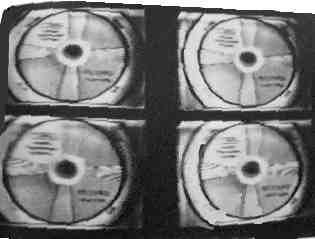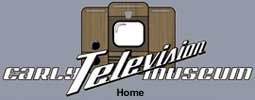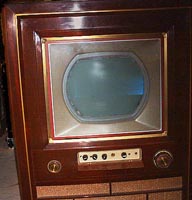The Set: Pete Deksnis's Site about the CT-100 Restoring a Vintage Color Television Set |
THE SET
Color a la 1951

from 60 to 72 cycles-per-second with the vertical hold control,
and if I had further been able to lower the horizontal frequency
from 15,750 to 14,580 cps, I could have seen the CBS sequential
color system broadcast as you see this CBS color test pattern --
four separate frames of the color transmission in black and white.
>
10 March 2001 A week after posting this page I got a call from a fellow collector who had actually performed such modifications to the family 630. He had found mods in an electronics hobby magazine. Not only did it work, but he failed to let the family know that their TV was so importantly improved. His Dad took the set to the RCA repair facility where the midnight mods got neutralized. This occurred in the New York City area within the coverage area of WCBS channel 2. Our youthful, future, collector reported that CBS transmitted this color test pattern after regular programming was completed for the day.
His followup email: "Pete. That's what I got when I messed around with the RCA 630 chassis....I never saw programming...just test pattern and audio tone..."
> 3 June 2001. Then, three months after posting this page, another email spelled out the same experience, but from a base in the Baltimore area. "In 1951 we had a 630 too. It was a Philmore kit that my dad and I assembled in 1948. Baltimore's WMAR-TV channel 2 telecast the feature race from Pimlico each afternoon in CBS color. I was able to turn the horizontal sync control and the vertical hold just enough to get a four-picture configuration of the horse race in black and white. That was my experience with CBS color. Regards, George Melton."
It was particularly exciting to me when I read what the programming was -- a horse race -- for it immediately fused a link with an 11-year old kid who listened to CBS color broadcasts so many years ago on his family's 16-inch Silvertone. He always associated some kind of sports narration with those memories -- a hazy picture in the mind's eye a football game. But a horse race... that floats smoothly in his memory. Fifty-year-old memories of mind-drawn color pictures of green grass, pale raceways, and chestnut steeds. Fortunately, there is a reality check: did WCAU-TV broadcast those races in 1951 in CBS color? --Pete
> 26 November 2006 Thanks to the latest version of "Ed Reitan's History of Color Television" the color broadcasts of a horse race over WCAU is assured. Here from Ed's site is the schedule of those broadcasts.
July 14, 3:45 P.M. “Racing at Monmouth Park” (NJ) [“Molly Pitcher Handicap”]
(over at 5:50 P.M.)
July 21, 4:15 P.M. “Racing at Monmouth Park” (NJ) [“The Lamplighter Handicap”]
July 28, 4:15 P.M. “Racing at Monmouth Park” (NJ) [“The Monmouth Handicap”]
Aug. 4, 4:15 P.M. “Racing at Monmouth Park” (NJ) [“The Choice Stakes”]
His followup email: "Pete. That's what I got when I messed around with the RCA 630 chassis....I never saw programming...just test pattern and audio tone..."
> 3 June 2001. Then, three months after posting this page, another email spelled out the same experience, but from a base in the Baltimore area. "In 1951 we had a 630 too. It was a Philmore kit that my dad and I assembled in 1948. Baltimore's WMAR-TV channel 2 telecast the feature race from Pimlico each afternoon in CBS color. I was able to turn the horizontal sync control and the vertical hold just enough to get a four-picture configuration of the horse race in black and white. That was my experience with CBS color. Regards, George Melton."
It was particularly exciting to me when I read what the programming was -- a horse race -- for it immediately fused a link with an 11-year old kid who listened to CBS color broadcasts so many years ago on his family's 16-inch Silvertone. He always associated some kind of sports narration with those memories -- a hazy picture in the mind's eye a football game. But a horse race... that floats smoothly in his memory. Fifty-year-old memories of mind-drawn color pictures of green grass, pale raceways, and chestnut steeds. Fortunately, there is a reality check: did WCAU-TV broadcast those races in 1951 in CBS color? --Pete
> 26 November 2006 Thanks to the latest version of "Ed Reitan's History of Color Television" the color broadcasts of a horse race over WCAU is assured. Here from Ed's site is the schedule of those broadcasts.
July 14, 3:45 P.M. “Racing at Monmouth Park” (NJ) [“Molly Pitcher Handicap”]
(over at 5:50 P.M.)
July 21, 4:15 P.M. “Racing at Monmouth Park” (NJ) [“The Lamplighter Handicap”]
July 28, 4:15 P.M. “Racing at Monmouth Park” (NJ) [“The Monmouth Handicap”]
Aug. 4, 4:15 P.M. “Racing at Monmouth Park” (NJ) [“The Choice Stakes”]
CBS sequential color test pattern
on a b&w TV adjusted as described above.

CBS sequential color transmissions, a color set
had a vertical oscillator that operated at 144 cps
and a horizontal oscillator running at 29,160 cps.
There is a color reporduction of this CBS test pattern on Ed Reitan's site.
[Created 3-3-2001; updated 6-3-2001, 11-26-2006]

